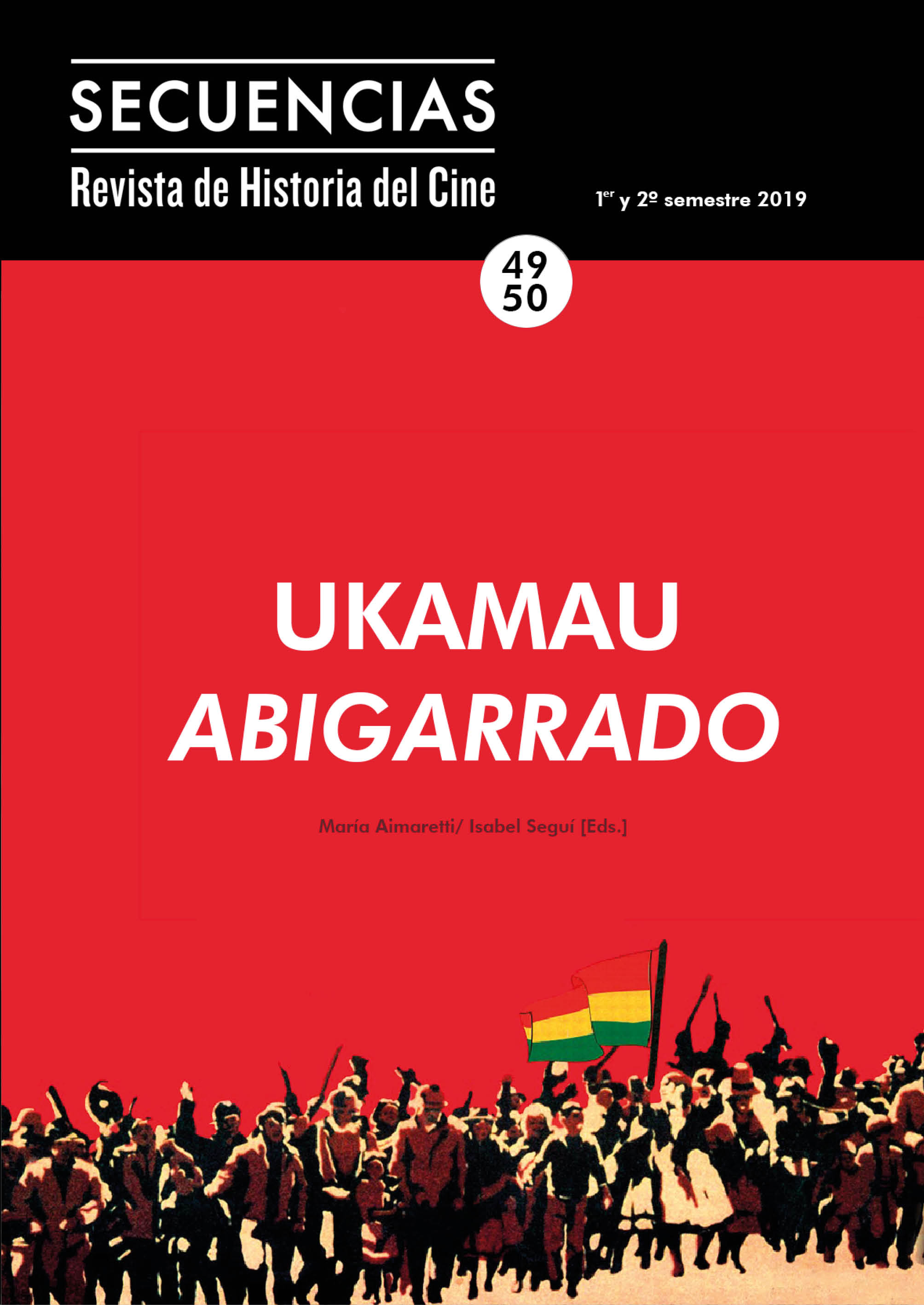The Ukamau Nation: Appropriations of the Cinematographic and Performing Indigenous Technique in The Secret Nation (1989)
Keywords:
Ukamau Group, Bolivia, integral sequence shot, Reynaldo Yujra, cinema, indigenous performance
This work is licensed under a Creative Commons Attribution 3.0 Unported License.
Abstract
From its origins the Ukamau Group unleashed the amazement of scholars, critics and film historians, as well as of hundreds of spectators around the world. From these first moments, the figure of Jorge Sanjinés eclipsed the panorama of film critics and film historians in the region. This has not been without justification, since he synthesized multiple processes of left-wing aesthetic. Without trying to minimize the merits of the most constant member in the production of Ukamau Group and of all Bolivian cinema, this work problematizes the figure of the «group», and reflects upon its film production. Many of the aesthetic merits of this film collective are not due to individual creation but to multiple and complex production processes that were enhanced by a collective authorship. As a result, the intention of this text is to discuss this relation, through Reynaldo Yujra's performance as an actor, by analyzing one of the most important film works in Bolivian cinema, The Secret Nation (Grupo Ukamau, 1989), where the theoretical and aesthetic proposal of indigenization was incipiently carried out through the integral sequence shot.
Downloads
References
AIMARETTI, María «Revivir la experiencia, narrar la masacre, impugnar la Historia: sobre el uso del testimonio en El coraje del pueblo (Grupo Ukamau-Jorge Sanjinés, 1971)» (Revista Afuera, 12 Año VII, 2012).
—, «Mirada-limen y memoria heterogénea: Acerca de La nación clandestina (Jorge Sanjinés, 1989)» (Secuencias: revista de historia del cine, n.º 42, 2015), pp. 127-154.
BAJO HERRERAS, Ricardo, «El tiempo circular de Jorge Sanjinés» (El ojo que piensa, n.º 0, agosto de 2003)
BONFIL BATALLA, Guillermo, «La teoría del control cultural en el estudio de procesos étnicos» (Estudios sobre las culturas contemporáneas, vol.4, n.º 12, 1991) pp.165-204
—, México profundo: una civilización negada (México, Consejo Nacional para la Cultura y las Artes, 1990).
CALDERÓN, Fernando, Movimientos sociales y política. La década de los ochenta en Latinoamérica (México, Siglo XXI, 1995)
GARCÍA PABÓN, Leonardo, La patria íntima. Alegorías nacionales en la literatura y el cine de Bolivia (Bolivia, CESU-Plural editores, primera edición, 1998).
GUMUCIO DRAGON, Alfonso, «Un debate sin Jorge Sanjinés» (Página 7, 5 de julio de 2017). Disponible en: <https://www.paginasiete.bo/cultura/2017/5/7/debate-jorge-sanjines-136789.html)>
—, Diario ecuatoriano. Cuaderno de rodaje (Ecuador, Consejo Nacional de Cinematografía del Ecuador, 2015).
NAHMAD RODRÍGUEZ, Ana «La insurrección de las imágenes. Cine y representación indígena en Bolivia» (México D.F., UNAM, 2009), pp. 208.
POOLE, Deborah, Visión, raza y modernidad. Una economía visual del mundo andino de imágenes (Lima, SUR, 2000).
RIVERA CUSICANQUI, Silvia «Alternatives Histories: An Essay on Two Bolivian ‘Sociologists of the Image’», en Invisible Realities: Internal Markets and Subaltern Identities in Contemporary Bolivia, (Quezon City, SEPHIS, 2005).
—, Ch’ixinakax utxiwa : una reflexión sobre prácticas y discursos descolonizadores (Argentina, Tinta Limon, 2010).
SANJINÉS, Javier, «Transculturación y subalternidad en el cine boliviano» (Objeto visual, Venezuela, año 12, n.º 10, diciembre de 2004)
SANJINÉS, Jorge, «¿Qué es y qué ha sido el cine del grupo Ukamau?», en El cine de Jorge Sanjinés (Bolivia, Festival Iberoamericano de Cine de Santa Cruz, 1999).
—, «El plano secuencia integral» (Cine Cubano, n.º 125, 1989).
SANJINÉS, Jorge y GRUPO UKAMAU, Teoría y práctica de un cine junto al pueblo (México D.F., Siglo XXI, 1987).
SCHIWY, Freya «La otra mirada. Video indígena y descolonización» (Miradas: Revista del audiovisual, n.º 8, 2005).
—, Indianizing Film: Decolonization, the Andes, and the Question of Technology. (Nueva Jersey, Rutgers University Press, 2009).
SEGUÍ, Isabel, «Saturnino Huillca, estrella del documental revolucionario peruano» (Cine Documental, n.º 13, 2016).
SOTO, Gustavo, «La profundidad del retorno», en El cine de Jorge Sanjinés (Bolivia, Festival Iberoamericano de Cine de Santa Cruz, 1999).
STANISLAVKI, Konstantin, El trabajo del actor sobre sí mismo (La Habana, Ediciones Alarcos, 2009).
WOOD, David, «Andean Realism and the Integral Sequence Shot» (Jump Cut: A Review of Contemporary Media, n.º 54, otoño de 2012).
—, El espectador pensante (México D.F., UNAM/La Carreta, 2018).
ZAMORANO VILLARREAL, Gabriela, Indigenous Media and Political Imaginaries in Contemporary Bolivia, (Lincoln, University of Nebraska Press, 2017). https://doi.org/10.2307/j.ctt1qft0pq

